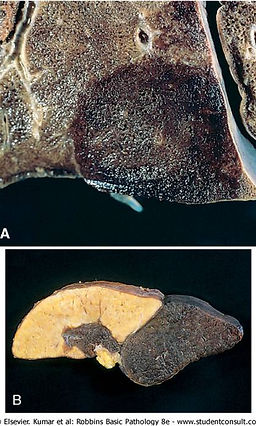Hemodynamics Disorders I
They are disorders that affect , in any way , the blood circulation of an individual, leading him to a pathogenic situation .
They are: ischemia , infarct , thrombus , embolus, hyperemia , atherosclerosis , edema , shock and hemorrhage. In this first part, we'll learn about ischemia , infarct , hyperemia , thrombus and embolus.
Ischemia
This is a deficiency in blood supply by reducing the light of the arteries, arterioles or capillaries to tissue or organ. It may occur for functional causes such as hemorrhage or mechanical causes such as vascular obstruction . The consequences depend on the type of tissue affected, the efficiency of the collateral circulation , the speed with which settles and the grade of reduction in the diameter of the affected artery in cases of obstruction .
Infarct
It is the necrosis resulting from interruption of arterial or venous blood flow and may be white, red and septic .
White , also called ischemic or anemic , occurs by arterial obstruction in organ of terminal circulation, presenting a white area. The red ( hemorrhagic ) occurs in organs of dual circulation where there is arterial occlusion or venous occlusion. In this type , the dual circulation leads to secondary hemorrhage . While the septic one occurs by bacterial vegetations on heart valve forming thrombi and hence emboli .
Hyperemia
It is the increased concentration of blood in a specific organ or part of it with vascular dilatation .
The hyperemia may be active / arterial or passive / venous / congestion. Active hyperemia is further subdivided into physiological or pathological and passive in local or systemic .
When there is an increase in blood flow by the increase of blood pressure (BP) or decrease of precapillary resistance , there is an active hyperemia . She is a physiological because of the increase in functional demand or pathological because of the release of inflammatory chemical mediators .
When there is an increase in blood flow by decreasing the venous drainage or increase in post -capillary resistance , there is a passive hyperemia . She is local if it affects only a specific blood vessel and systemic if it generates a stasis throughout the circulation.
Thrombus
It is a solid mass formed by the blood coagulation , whereas thrombosis is the solidification of the constituents of blood. It can be arterial or venous , but more often it happens in the veins because of their size .
To speak of thrombus , we must speak of Virchow's Triad . This triad consists of changes in blood flow , endothelial damage and hypercoagulability in blood.
In the change of flow, stasis can cause margination and promotes cellular aggregation, while the turbulence causes injury to the endothelium and exposes collagen which promotes platelet aggregation. Both then lead to accumulation of cells that form the thrombus .
An endothelial damage, which may occur from trauma or increased blood pressure for instance, exposes the subendothelial collagen, originating platelet aggregation on the coagulation process. Thus, the thrombus is formed.
Finishing the triad, some people may have a genetic tendency to hypercoagulability , favoring thrombus formation by generating clots too easily . Moreover , factors such as permanence on bed and stay in prolonged immobilization promote blood stasis and therefore thrombus formation .
The thrombus can detach from the place of origin and travel through the bloodstream . From this, there is the formation of a emboli . Or thrombus may dissolve and reorganize by fibrinolytic activity , it can propagate or recanalize .
Embolus
It is a solid , liquid or gaseous intravascular mass that is carried by the blood to a distant location from their point of origin .
The emboli can be classified into solid, liquid and gaseous. Exemplifying a thromboembolism is a solid emboli coming from a thrombus . Fatty embolism is an example of liquid emboli caused by the addition of droplets of bone marrow and blood , while a gaseous emboli can be formed when divers return to the surface incorrectly.

Hyperemia x Congestion

Liver with congestion and hemorrhage

Platelet adhesion

Coagulation

Platelet adhesion and aggregation

Coagulation cascade

Coagulation cascade

Thrombim in the cellular activation process

Fibrinolytic system

Virchow's triad

Emboli

Thrombi

Emboli


Infarct
Infarct
Bibliography:
KUMAR V, ABBAS AK, FAUSTO N. Robbins & Cotran: Bases Patológicas das Doenças. 8ª edição. Rio de Janeiro: Elsevier, 2008.
BRASILEIRO FILHO, G. Bogliolo: Patologia. 7ª edição. Rio de Janeiro: Guanabara Koogan, 2006.
RUBIN E, GORSTEIN F, RUBIN R, SCHWARTING R, STRAYER D. Rubin: Bases Clínico-Patológicas da Medicina. 4ª edição. Rio de Janeiro: Guanabara Koogan, 2006.
BRASILEIRO FILHO, G. Bogliolo: Patologia Geral. 4ª edição. Rio de Janeiro: Guanabara Koogan, 2009.
MONTENEGRO MR, FRANCO M. Patologia: Processos Gerais. 4ª edição. São Paulo: Atheneu, 1999.






